UPDATE: This guide was published at the perfect time. I hadn't republished an article for months, but three days after this guide was published, an article I'd submitted for republishing to Elite Daily months ago went live, proving just how well republishing works.
I took the screenshot below of my Aweber dashboard on Saturday at 9:30 AM: 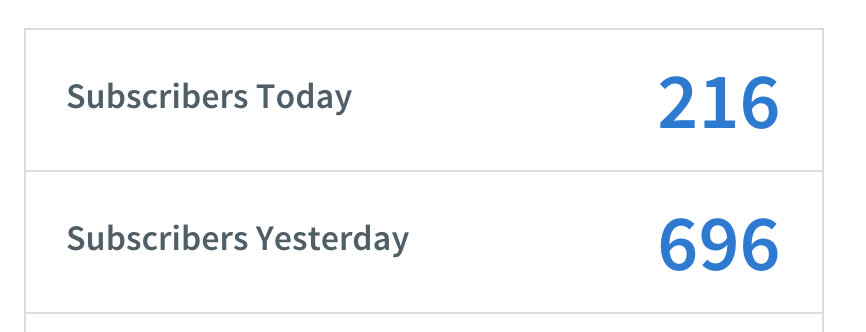 By the end of the day on Saturday, I had accumulated another 355 subscribers just from the one republished post. It's noon on Sunday as I write this and today alone has brought in over 125.
By the end of the day on Saturday, I had accumulated another 355 subscribers just from the one republished post. It's noon on Sunday as I write this and today alone has brought in over 125.
Cumulatively, over the past 60 hours, one republished article brought in well over 1,000 new subscribers.
That's the power of what you're about to learn.
You’ve heard it over and over again…
"Guest posting is a great strategy for getting traffic to your website and increasing your email subscribers”.
And maybe you’ve tried it before. Maybe you’ve even seen some traffic and conversions from guest posting. But there’s one hitch holding you – and most people – back from guest posting more often:
It’s time-consuming.
So what if I told you there was a way to increase your traffic and conversions through being a guest on another publication…
But without having to create, write, and pitch a whole new article?
James Clear used this tactic to build his blog up from 0 to 250,000 unique visitors per month in two years. He did it without having to write anything new.
What’s the tactic?
Republishing.
Specifically, taking those articles you’ve worked so hard to write and republishing them on platforms far larger than yours.
If it sounds out of your league, don’t worry. I’ll take you through a step-by-step process to pitch and republish your content, including:
-
Finding publications to republish your content on
-
Pitching those publications
-
Optimizing your republished content for conversions or traffic
-
How to make every piece of republished content work even harder for you.
But first, let’s talk about why you should definitely republish your content for traffic and subscribers.
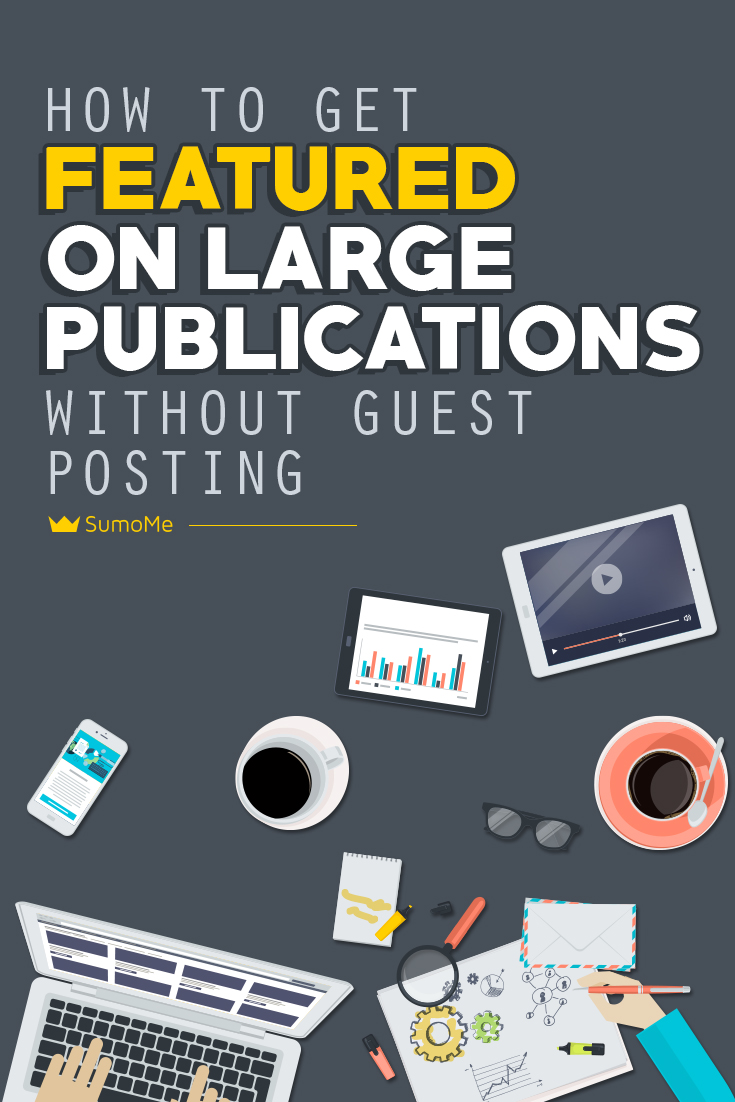
Why Republishing Needs to be Part of Your Content Marketing Strategy
Republishing is, without a doubt, an extremely effective way of generating traffic for your website.
But why is it effective? And, more importantly, how effective is it?
Let’s start with why:
Every piece of content you create takes a certain amount of time. If you’re truly committed to creating the best content out there on your topic (and you should be), content creation takes a lot of time.
Think about the last article you wrote. How long did it take?
5 hours? 10? 20?
For us, one of our Sumo-Sized guides (like our guide on the 130 ways of getting more traffic) takes well over 20 hours to put together – and that’s not even counting the spreadsheets we’re notorious for.
Our expanded list guides, like our Content Upgrades and Headline Formulas posts take anywhere from 5-15 hours to write, not including research, upgrades, or extras.
Even if you only take a fraction of the amount of time we take to write a killer guide, you’re still spending hours putting together content that might be consumed by no more than a few thousand people – if you’re lucky.
Since you’re working so hard to create awesome content for your audience, why not make it work harder for you?
That’s where republishing comes in. When you republish your content, you’re taking that content you worked so hard to create, and getting it in front of the eyes of another platform’s audience.
Often, the publications that republish content are gigantic media companies that have equally gigantic audiences – and therefore, gigantic content needs with hundreds or even thousands of pieces published daily.
Because of the reach of these huge media platforms, republishing can be extremely lucrative when you boil it down to return on time investment.
On Lesson 4 of Email1K, James Clear explains how he landed 600 email subscribers from one piece of republished content.
I’ve had republished content drive hundreds (sometimes thousands) of visitors to my personal blog, exposing it to an entirely new audience base, and rapidly building my email list from simply putting the content that I’d already worked so hard to produce in front of new eyes.
For example, every Monday I publish an article on my personal blog, Unsettle. After publishing this article:
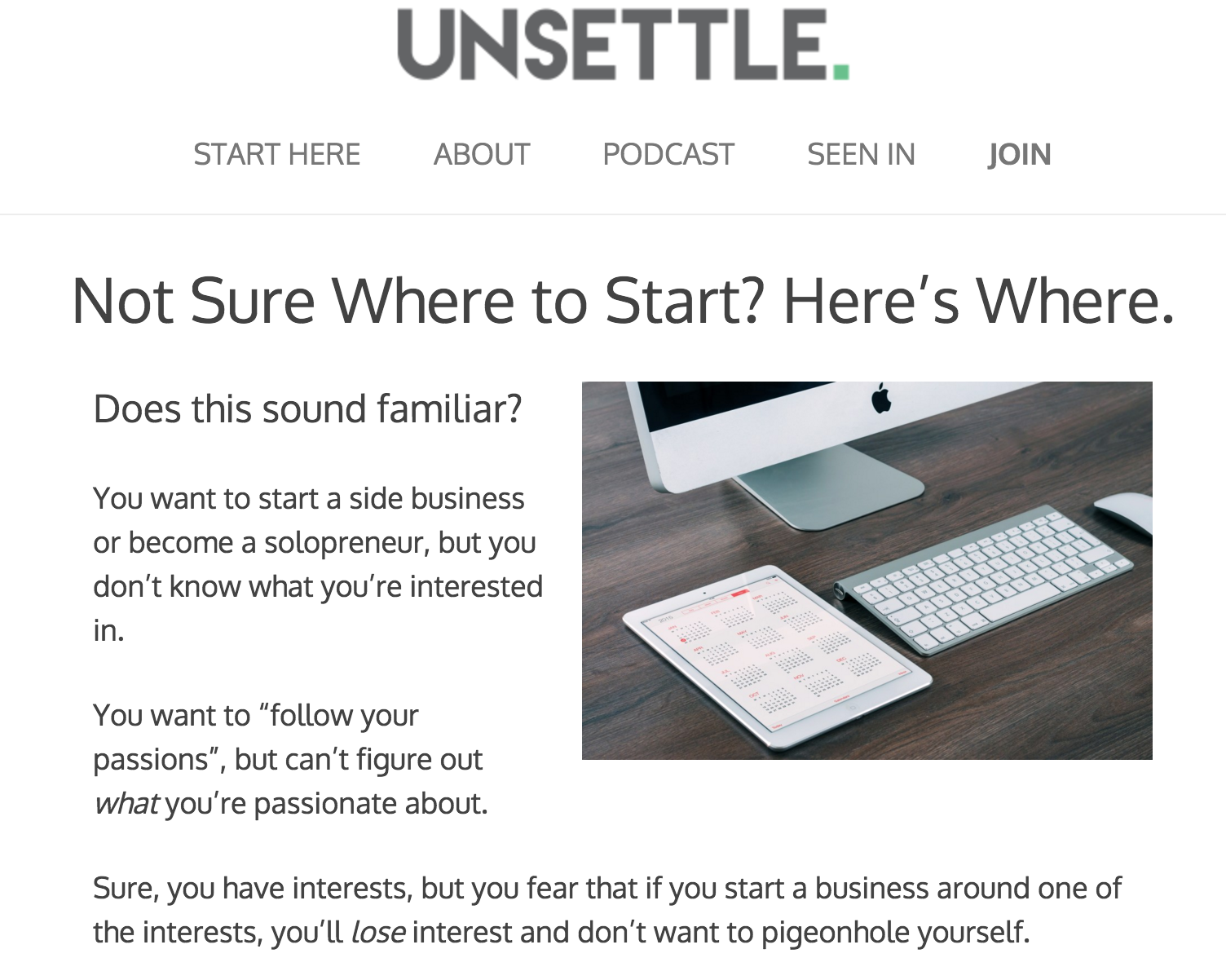
I republished it on Elite Daily, which garnered over 10,000 social shares:

As you can imagine, Elite Daily’s audience is much larger than mine, so I was able to get that already-written content in front of tens of thousands of eyes I wouldn’t have been able to reach otherwise.
Because I had a few key elements in place (which I’ll go over in a minute), that article that took me just a few minutes to republish gathered over 230 new email subscribers from Elite Daily the day it went live.
There are also fringe benefits to republishing your content. For example, you’re building relationships with the editors and sometimes owners of these larger publications. You’re also building backlinks from large, high authority websites.
Sounds pretty great, right?
But you may have heard a nasty rumour about republishing. One that scares people away from even trying it to begin with…
The idea that Google penalizes for duplicate content.
Why It’s Actually a Myth That Republishing Will Negatively Impact Your SEO
Some misinformed people say that republishing your content on other websites hurts your SEO.
I get the logic behind it. We’ve been taught that republishing means duplicating content, and duplicating content is not only spammy, but confusing.
But unless you’re out there spamming the web by ripping off other people’s content and posting it on your own website – and unless your website is already looking pretty spammy – you’re good to go.
In fact, Matt Cutts, Google’s “head of webspam” said so himself.
The only real hitch you may experience is tripping Google up with which piece of content to show in search results.
As Dan Shure generously answered in a recent comment on our guide 130 Ways to Get More Traffic to Your Website:
“The potential issue with duplicate content is only that Google might not know which one to rank, or they might choose to rank someone else's site over yours.
So – if you want to re-publish something on Medium, that was on your blog, do this just with the assumption Google may rank and give traffic to the Medium.com version since they have the higher domain authority.”
Luckily, there’s a fix for that:
Use the canonical tag.
This is an html tag that communicates with the search engines to let them know which content to use in results.
Paste this in the republished version of the content, replacing the link with the original URL:
<link rel="canonical" href=http://yoururl.com/original”>
Here are a few more things you can do to make sure the original version of the content is ranked rather than the republished version:
-
Wait before republishing to ensure search engines have indexed your content. Usually a few weeks will be more than enough. After a few weeks have passed, pitch or republish your content on other websites (we’ll get to how to do that in a minute).
-
Change 20% – 25% of the content. This is not a proven practice by any means, but many publications request this to be done anyway.
-
Choose a different headline. This may not have a huge impact on your rankings, but it’s a unique opportunity to test different headlines to see what works with your audience and your target audience.
If nothing else, republishing provides a link building opportunity to your content, which is good for search engine rankings.
So now that I’ve convinced you that it’s a good strategy, and that Google won’t give you the smackdown for doing it, you might wonder exactly how to do it. Don't worry, I won't leave you hanging.
The Step-by-Step Guide To Republishing Your Content on Other Sites
You may have heard the stories…
Blogger writes an awesome article, and goes viral when their post is picked up by Lifehacker or some other gigantic website.
That’s the dream, right?
But instead of sitting back and waiting to win the republishing lottery, make your own luck.
First, we’ll go over where to find places to republish your content. Then we’ll talk a bit about how to approach them about republishing, followed by best practices and how to make the content super effective.
Step 1: Find Publications in Your Industry that Republish Content
One of the first questions people tend to ask when they hear about the benefits of republishing content is how they can find publications that actually do the republishing.
There isn’t an exact science to finding the websites that take republished content, and often you find these websites as you go along.
But if you’re chomping at the bit to start republishing your content, click the button below to get the free spreadsheet with 46 of the top publishers that republish content (complete with contact info):
Search Popular Publications in Your Industry
Start by listing out all the publications in your industry (and even some more general ones that hit a variety of topics, like Huffington Post).
Remember: the larger the publication, the greater their content needs; the greater the content needs of the publication, the more likely they republish.
Once you have a solid list of publications, you can start by visiting their “contribute”, “write for us” or “guest posting” guidelines page. If you can’t find that page, Google search “inurl:http://website.com “keywords”” to pull up results.
le, if The Good Men Project were on your list, a quick search of their website for “Contribute” brought up their Project Submission and Style Guidelines:

When you’ve found that page, press control + f (command + f for Mac users) to quickly search the page for “published” “republish”, “syndicate” or “repost”.
A quick search of The Good Men Project brought me to the section where they claim to take previously published content:

The same search of Elite Daily brings me to the section where they claim they no longer do:

Contributor guidelines usually address this, but if not, you can always email the editor to find out.
Search for Influencers in Your Industry
Influencers recognize the opportunities provided by republishing your content, and have used this method to grow their own audiences.
After a certain point, you’ll be approached by publishers looking to republish your work – you’ll no longer have to pitch. Influencers are often approached, so a great place to find publications that republish is find out where those influencers republish their own work.
Do this by searching the influencer’s name plus phrases that indicate the piece was republished – for example “originally published on”.
For example, if you were to do this with my name, you’d find the work I’ve republished on Huffington Post, Entrepreneur.com, Elite Daily and Fear Average (plus several results entirely unrelated to me, which you come to expect when you have the world’s most generic name).
 If a publication has published in the past, chances are they’ll republish in the future. After you find these publications, check their guidelines to see if they still republish content.
If a publication has published in the past, chances are they’ll republish in the future. After you find these publications, check their guidelines to see if they still republish content.
As you compile this list, use Google Sheets or another way of tracking the results so you don’t waste time in the future relying on just your memory. Cross out any that don’t republish and flag any you’d like to pursue first.
If you checked off all of the boxes, you can move onto the next step…
Step 2: Find the Perfect Content For Each Publication
Whether you’re republishing, guest posting, or even just being interviewed on another platform, it’s crucial to match the style, tone, and type of content their audience has come to expect from that blog.
So now that you have a list of target publications, identify your first target, open BuzzSumo, and get ready to do some research.
BuzzSumo filters out the most popular content on a website (sorted by social shares), so you can see what topics and type of content has performed well in the past.
Let’s say I decided I wanted to be republished on Business Insider. When I type Businessinsider.com into BuzzSumo, here are my results:
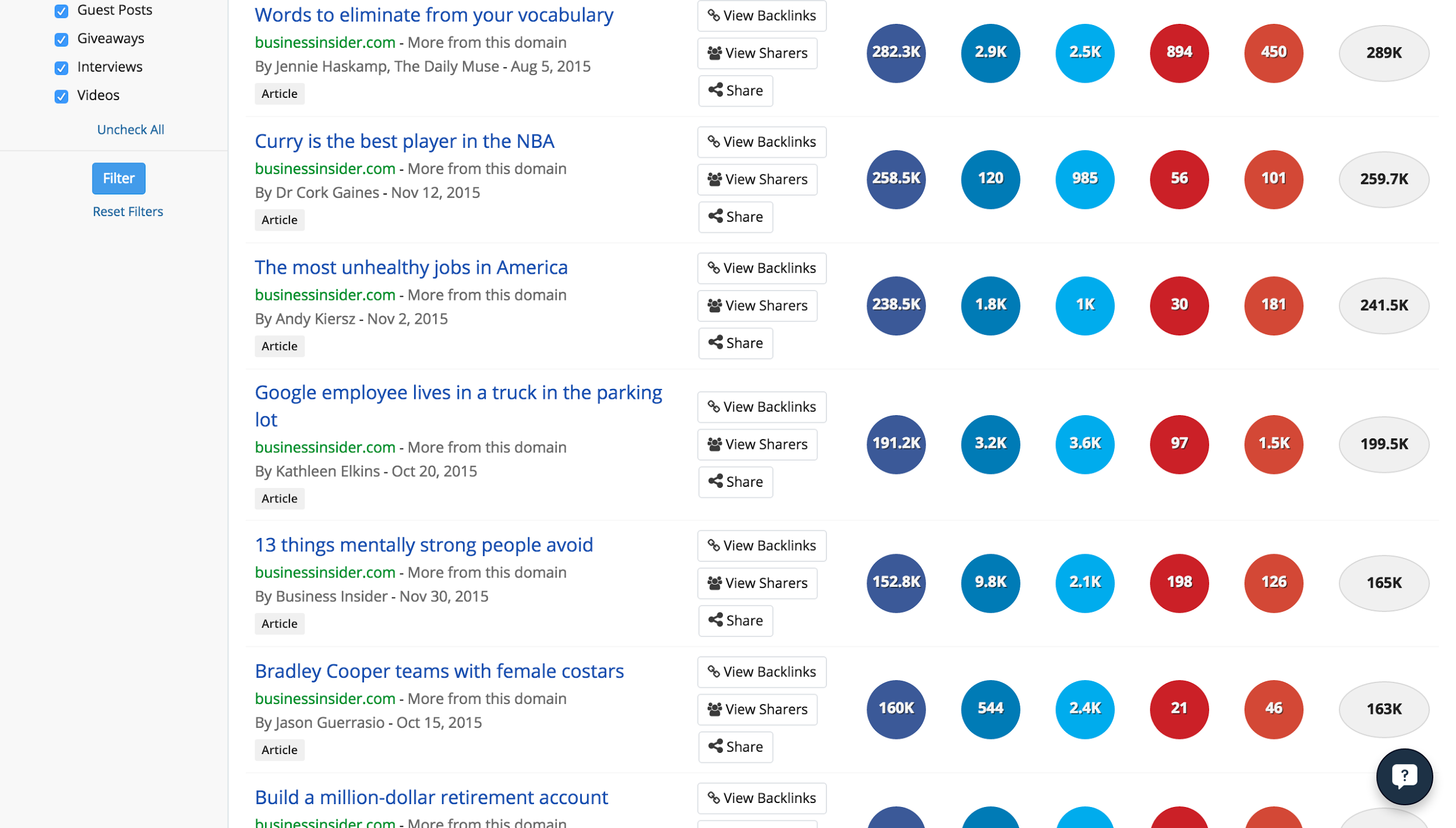
Some of the results are celebrity and news stories, so I’ll ignore those. The top evergreen article topics include unhealthy jobs, million-dollar retirement accounts, vocabulary and mentally strong people. Only one of the top posts is a list post (13 things mentally strong people avoid).
Armed with this knowledge, I would then go back into my archives to find a post that fits the bill. When you’re doing the same research, look for content you’ve published previously in the same or similar topics and format as the high-performing posts on the publication.
Remember that not all of your content will be suitable to republish on every site that allows republishing. For example, I couldn't submit my article on how to choose a domain name to Elite Daily because it's not appropriate for their audience. But my article about choosing a business idea was just up their audience's ally.
If you checked off all of the boxes, you can move onto the next step…
Step 3: Craft a Compelling Republishing Pitch
After you’ve identified your first target and found the perfect article for the website, it’s pitch time!
Since you likely already found the publication’s guidelines when you were checking if they take republished content, take this time to read through their contribution guidelines.
Often, you’ll get information on how to pitch your content in these guidelines, which will be helpful in getting your pitch accepted. Aside from following direction, here are a few ways to ensure your content is accepted.
Pitch Original Content First
If you’re pitching a site like Huffington Post or Elite Daily and you want to republish consistently, it’s best to write one original article first.
Remember that you have to rise above and stand out from the crowd. Pitching a unique piece of content tailored specific to the publication will help you get an author profile, which will give you a lot more freedom later on.

There are plenty of publications you can get away with pitching republished content to right off the bat, but avoid this with more “in demand” platforms.
Pitch to the Right Editor
To ensure your pitch will be accepted it’s important to get the pitch in front of the right person. You can usually find contact information for the editorial team on their “team” or “contact” page, or even their contribution guidelines. For example, the Huffington Post has the contact information on their “About Us” page:

Often, the publication will have a generic email address for pitches, like the Huffington Post does:

I usually send the pitch to the editor of the section I’d like to see my work on, and copy the generic email address. Often that generic address becomes a wasteland of pitches.
Or you can make it easy on yourself and use our free spreadsheet.
If the publication doesn’t list the email addresses of the editors, try the most common variations:
firstname.lastname@example.com
firstinitiallastname@example.com
How to Craft the Perfect Pitch
I don’t need to tell you that your pitch is the difference between having your content accepted and having it rejected. Right?
Editors get a constant barrage of generic pitches to their inbox. Whether you’re pitching a guest post or your republished content, you need to make your pitch stand out and personalize it.
This means no copy and pasting your last pitch!
The elements of a great pitch include:
-
A eye-catching subject-line
-
Addressing the editor by name
-
A personal connection point
-
A quick explanation of why and how your content will serve their audience
-
The content itself in the body of the email (many editors won’t bother opening links and documents)
-
A link to the content.
I wanted to make it super easy on you to execute this information, so just copy, paste, and change this pitch email:
Subject: [Something eye-catching and not generic]
“Hi [Editor name],
[Personal connection point]
I recently wrote an article about [topic] which my audience has enjoyed. I think [publication name’s] audience would love the article as well, because [why?].
I’ve included the article in the body of this email below, and if you’d rather check the original article out here is the link:
[link].
If you enjoy the article and think it would be a good fit, I would love to have it republished on [publication name].
Let me know what you think.
[Your name]”
If I were pitching the editor for the Business section of The Good Men project, for example, I might send the following pitch:
“Hi Kimanzi!
I interviewed you for my podcast in 2015 and my listeners loved your episode. Thank you again for coming on the show!
I recently wrote an article about finding a business idea which my audience enjoyed. I think The Good Men Project’s audience would love the article as well, because you’ve recently published an article about starting a business, and a few people who commented said they would love to start one but didn’t have an idea.
If you enjoy the article and think it would be a good fit, I would love to have it republished on The Good Men Project.
Let me know what you think.
Sincerely, Sarah
[Body of article]”
Once you’ve crafted the perfect pitch, you’ll want to know how to…
Step 4: Set Your Content Up for Massive Success
So you’ve pitched your content, and it’s been accepted.
Congratulations!
Now you just have to make sure the effort pays dividends. Here are a few best practices to follow to increase the clicks, likes, shares, and most importantly, traffic and conversions:
1. Set an Objective
It’s impossible to know if something is effective if you don’t have an objective. What are you hoping to achieve with your republished content?
If you’re reading this, chances are you want more traffic to your website. Traffic could be your main objective for republishing.
But often email subscribers are the main goal, and people hope to convert their traffic – or, even better – convert directly from the republished post.
So before you begin republishing – as with anything you do – set an objective for it. What do you want to accomplish? The two most common and lucrative objectives are for traffic and email subscribers.
Once you have set your objective…
2. Get the Content Ready for Republishing
When you’re republishing content, it’s your responsibility to send the content to the publisher, who will usually request that you send them the content (don’t expect that they’ll pull it off your website for you).
If you have an author profile where you can load the content directly, you’ll have a bit more freedom over how you treat it, but sometimes that comes later.
Don’t just send the publisher the content as you have it on your website. Spend the time to ensure that it will meet your objectives.
-
Review links back to your other content: Usually, you’ll have internal links within your content that refer back to other pieces of content. Most of the time when you republish your content those links will remain the same. However, it’s a good idea to review them to see if they are the ones you want to remain in the republished version. Do NOT spam or go overboard with links. One or two links back to your website will be far more compelling for the reader to click than if every second sentence has a link.
-
Make any changes to the content: If you want to take the approach of changing 20-25% of your content just in case, this is your opportunity to do it. Make any changes you want to before sending it to the publisher.
-
Tweak the format to fit in with the publication: Even if you’ve already been accepted to republish your content, you still need to make sure it fits in with the publication. You did the research to pitch the content most likely to fit in already, but if it’s still not a perfect fit, you can always rearrange the information and change the format.
-
Follow the contributor guidelines: Most publications are pitched dozens of articles every day. To stand out and make sure you make your submission is accepted, follow the contributor guidelines, even if that means changing core points in your original piece. Be sure to follow the public guidelines the publication sets, as well as any guidelines they send you through email. Elephant Journal for example has specific guidelines for republishing, which I found out about through an email:
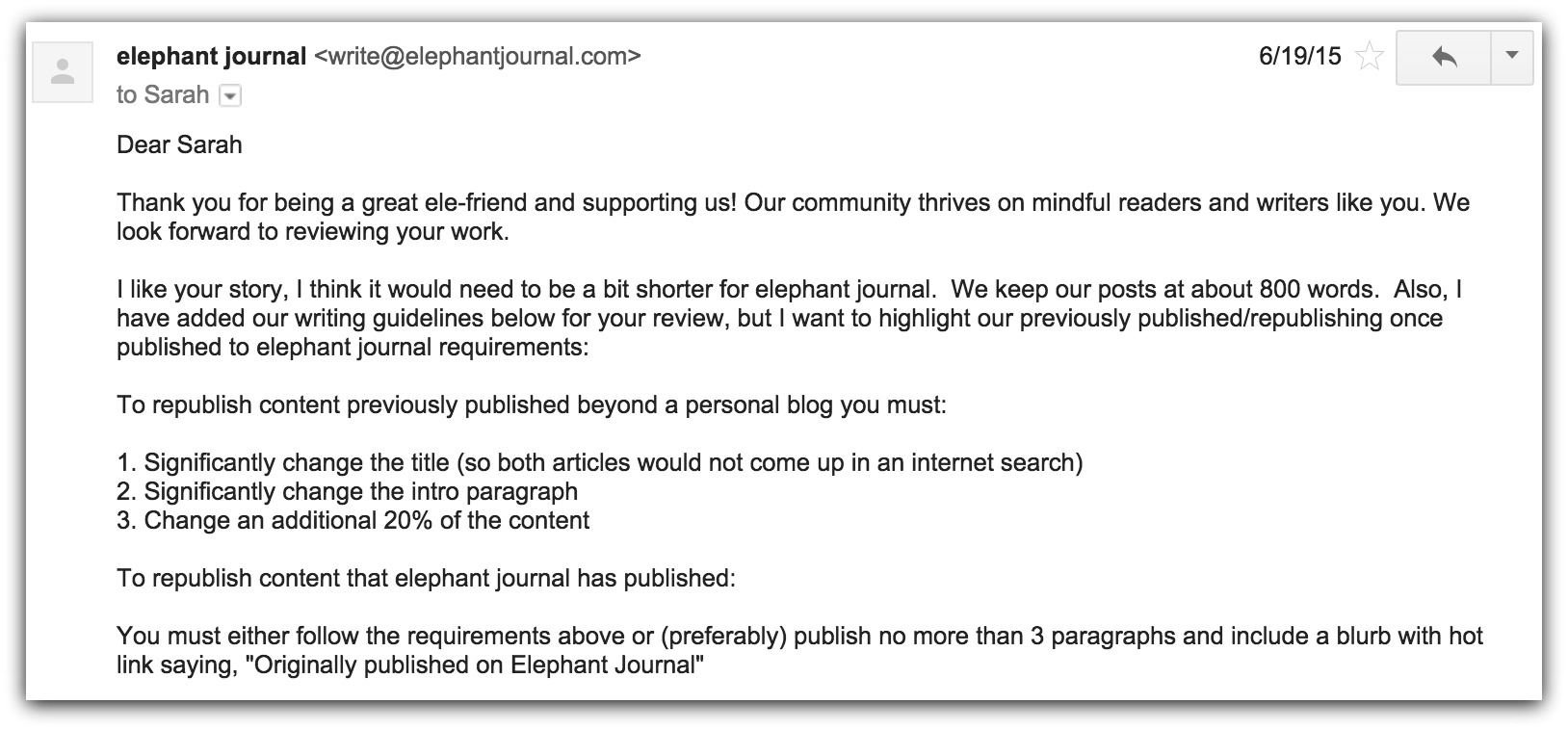
-
Make it so easy the editor can’t say no: You want to make it as easy as possible for the publisher to say “yes” to the post, so it should be something they can just load into their content management system and schedule.
For example, if you want canonical tags, make sure to put the post into HTML and include the tags. Don’t give the editor more to do than they already have.
When the content is ready for republishing, time to open up your email and…
3. Send the Publisher Your Content
Once you’ve made the content ready for republishing, it’s time to send the content to the publisher.
But don’t just load the submission into email and press send. Go the extra mile to make the submission work double-time for you.
When you’re sending the editor your submission, include a bio at the bottom of the post. Let them know in the body of your email that you’ve included it, and request that it remain at the end of your post instead of in an author box, like my article on Elite Daily:

It’s almost pointless to have an article republished otherwise – for example, Lifehack.org gives their authors very little credit for their work:
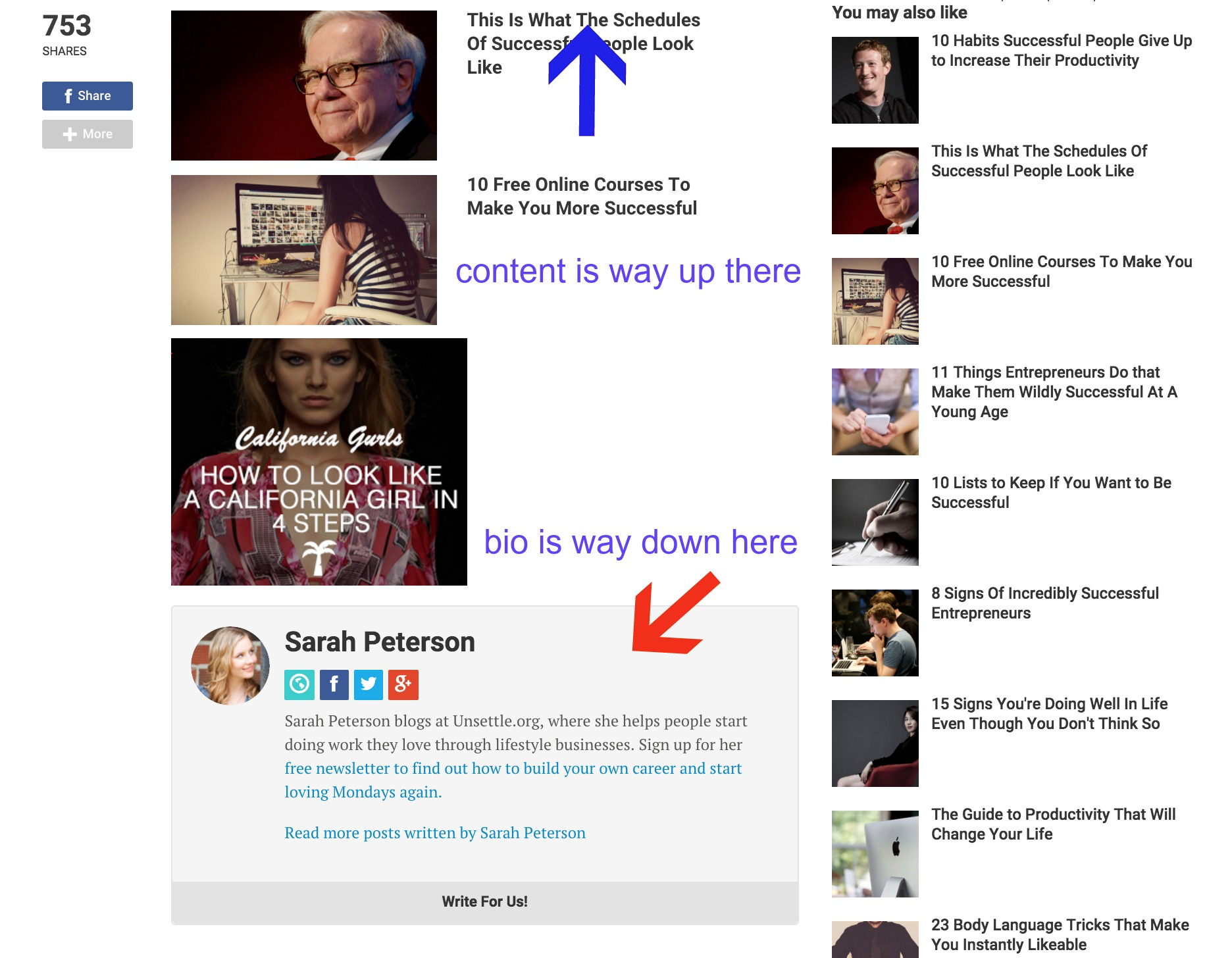
When your bio is actually just an extension of your submission, people are far more likely to read it and take action on your call to action. Author boxes usually isolate your information from the post and most people don’t read them.
If your objective is to get more traffic, ensure your call to action is as benefits driven as possible. If they click the link to your website, what problem will your website solve for them?
If your objective is to get more email subscribers, create a content upgrade to use as an opt-in offer that compliments the content you are pitching to republish.
After you’ve created a bio, and made it so easy to accept your piece that the editor can hardly say no, get ready to capture the best possible results.
Don’t skip this step! It’s one of the most important steps.
Step 5: Set Your Website Up to Capture More Leads
While republishing your existing content is far easier than guest posting, there are still a few things you should be doing when your piece goes live on the other website to make sure your efforts pay off.
Create Related Content
Let’s say you get your cherished piece of content up on the larger publication.
A reader enjoys it enough to read to the end. They see your bio, follow your call to action and wind up on your website. Why let that forward-moving momentum with your website go waste?
You may have a new fan on your hands, but why not give them even more to do? Do this by complementing the topic of the republished content – the topic they originally found out about you from.
Schedule a piece of complementary content to go live on your own website for those who were interested enough to follow your call to action.
Optimize Your Calls to Action
Whether your objective through this republishing process is traffic or email subscribers, when the audience of the host publication lands on your website, it’s still important to capture their information so you can continue to communicate with them.
When the republish date comes along, optimize your Welcome Mat, List Builder and Smart Bar to capture those visitor’s information. Make it even more enticing for the visitor to enter their information by creating an opt-in offer that compliments the topic of the republished post.
If you want to get really fancy, you can even create custom calls to action based on what site they’re coming from.
Track the Results
Like Noah says, “track it or it didn’t happen”.
Republishing your content can be an opportunity to validate an idea – specifically whether your target audience is interested in the specific topics you’re creating content about.
Often the best product and service ideas are already validated through content. If you republish your content on a larger platform and it gets very little engagement, you know your target audience may not be interested in the topic (or at the least, your angle). This will save you from spending your time, money and effort in the future with creating content or even products your audience doesn’t want.
Republishing truly is a great way to grow your traffic, email list and business with very little extra work.
Bonus Tips for Republishing
Haven’t had enough of this republishing goodness? Here are some bonus tips:
Create a Republishing Policy
As I republish my content on other platforms, this sends a message to other publications in my niche that I’m open to republishing. Every time one of my articles gains traction on a larger website like Huffington Post, I receive an email or two from another publication (usually one I’ve never heard of before) asking to republish an article from my website.
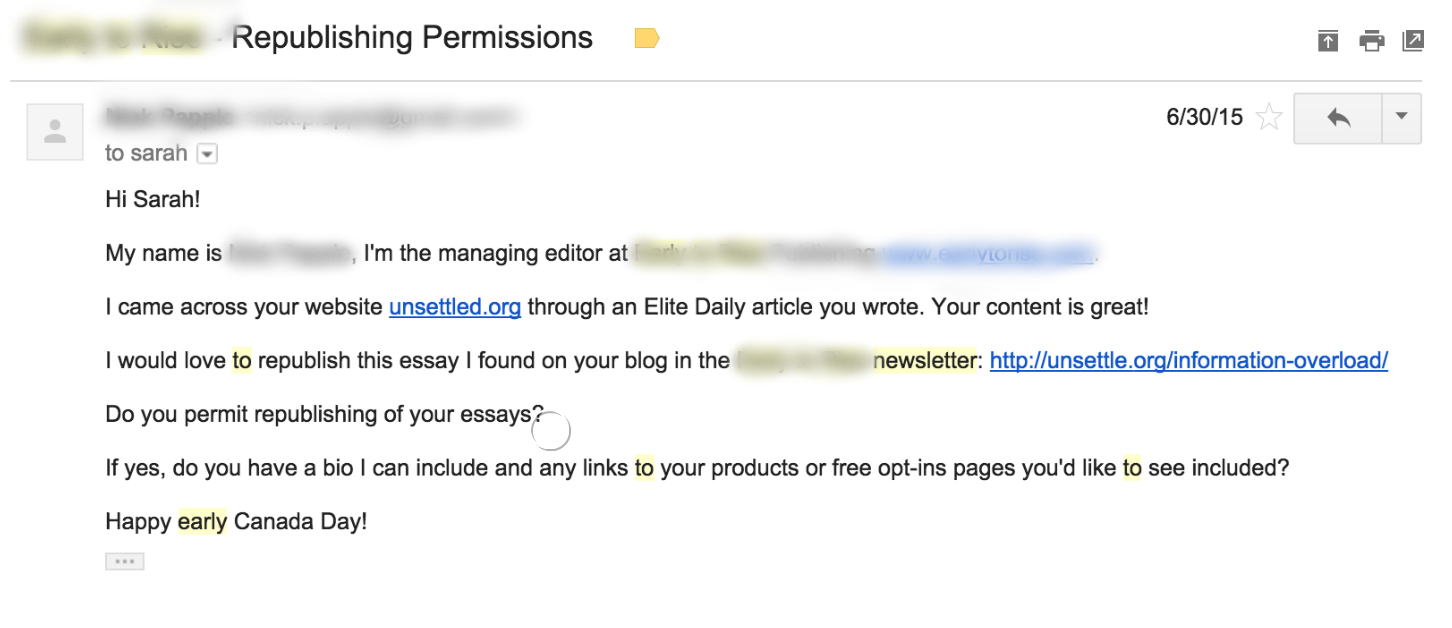
To encourage those people to actually contact you, it wouldn’t hurt to have a page on your website addressing it.
Republish Your Guest Posts
Don’t forget about the content you’ve published on platforms other than your own! If you wrote guest posts or publish on other websites, don’t be afraid to approach those publications and ask if they are okay if you republish on other websites.
Often they will respond with some guidelines for republishing, like Fast Company did when I asked if I could republish my guest post to Huffington Post:
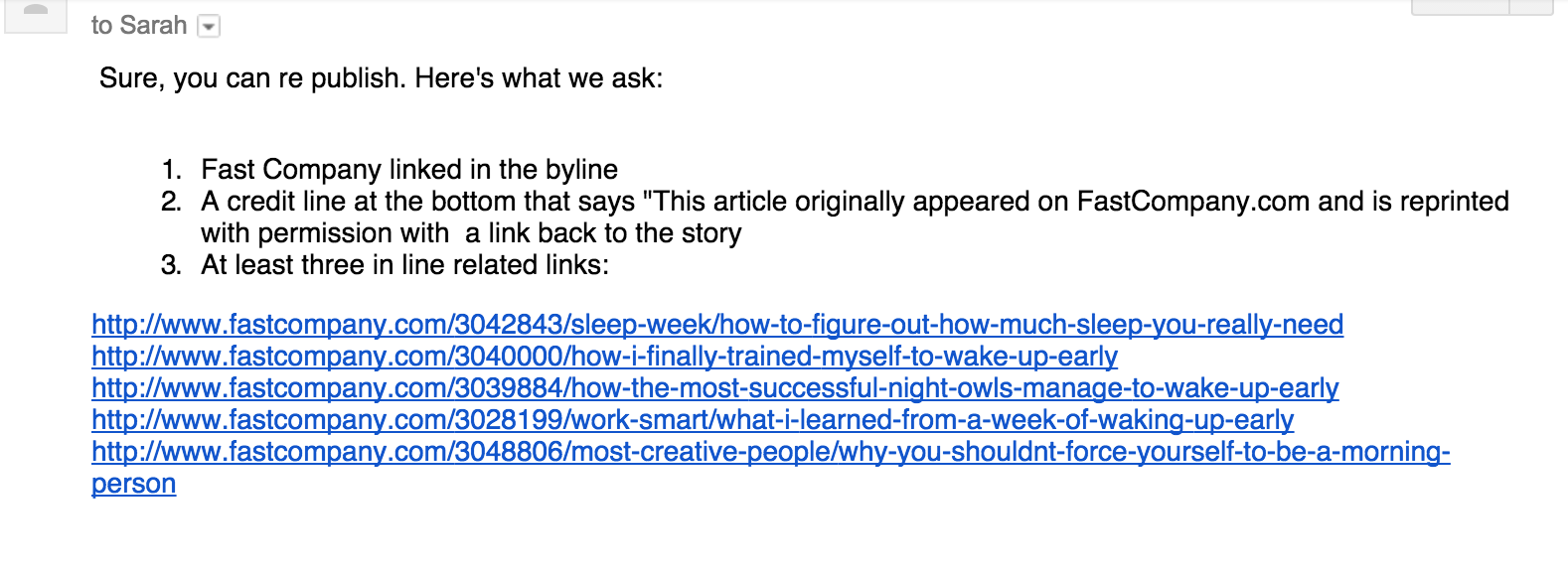
You give up rights to your content when you publish guest posts on other websites so always ask – but it doesn't hurt to get your content on as many publications as possible.
Stop Letting Your Content Rot in Your Archives
Publishing your content only to your small audience is like trying to deliver a speech to your neighbors in your living room.
Sure, it might help a few people, but your time and effort will have a much larger impact if you move the show to the hall full of people down the street.
Stop letting that content rot in your archives. Start republishing to drive traffic and subscribers back to your website.
Step one: List out a few publications in your industry and find out whether they republish content. Do the research to find a piece of content you’ve published that would fit in.
Step two: Pitch a piece of content that would be perfect for the publication.
Step three: When your pitch is accepted, send them the edited version of your content. Sit back and watch the traffic roll in.
Remember: you don’t have to republish on EVERY website out there. Start with one, conquer it, and approach others.
And don't forget to grab our free spreadsheet with the 46 top sites that take republished content and their contact info: Let us know how it goes. Have you ever considered republishing in your content marketing plan?










Add A Comment
VIEW THE COMMENTS